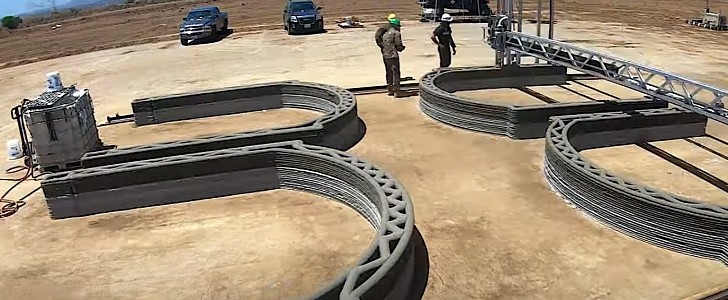3D printers are incredible machines. They’re just as exotic as Star Trek’s food replicators, or the teleporter, only real. And in no time, they’ll probably reshape our world.
In the auto industry the technology has just begun being used, and for now is limited at churning out small components that go into cars. Despite many promises, we’re yet to see a fully functional 3D printed car.
There are many types of 3D printers, and most of them don’t actually fit the classic definition of the word. The one we’re going to talk about here, called Vulcan, certainly does not, even if its maker, ICON, refers to it as such.
ICON is in the business of making 3D-printers for homes for a while now. As in not to be used inside the home, but to actually make it, using a substance called Lavacrete, a polymer concrete.
Vulcan is an 11.5 feet (3.5 meters) tall machine that spits layer upon layer of Lavacrete in whatever shape its operators feed into its systems. It can create in thin air walls as high as 8.5 feet (2.5 meters) and foundations as wide as 28 feet (8.5 meters), although technically the length of the build is practically infinite.
The trick is Vulcan does this very fast, and the end product is ready for use in no time. With an operating speed of between 5 to 7 feet per second (1.5 to 2 meters), Vulcan can guarantee the creation of a structure very fast, wherever you need it.
Like say on a battlefield, to help you hide a HIMARS multiple launch rocket system from the enemy’s prying eyes. At least that’s what a U.S. Marine Corps unit showed recently at Camp Pendleton in southern California.
You can watch how the entire action unfolded, and get a better understanding of what it takes to 3D-print buildings in the video attached below. According to ICON, it took the team just 36 hours from start to finish.
There are many types of 3D printers, and most of them don’t actually fit the classic definition of the word. The one we’re going to talk about here, called Vulcan, certainly does not, even if its maker, ICON, refers to it as such.
ICON is in the business of making 3D-printers for homes for a while now. As in not to be used inside the home, but to actually make it, using a substance called Lavacrete, a polymer concrete.
Vulcan is an 11.5 feet (3.5 meters) tall machine that spits layer upon layer of Lavacrete in whatever shape its operators feed into its systems. It can create in thin air walls as high as 8.5 feet (2.5 meters) and foundations as wide as 28 feet (8.5 meters), although technically the length of the build is practically infinite.
The trick is Vulcan does this very fast, and the end product is ready for use in no time. With an operating speed of between 5 to 7 feet per second (1.5 to 2 meters), Vulcan can guarantee the creation of a structure very fast, wherever you need it.
Like say on a battlefield, to help you hide a HIMARS multiple launch rocket system from the enemy’s prying eyes. At least that’s what a U.S. Marine Corps unit showed recently at Camp Pendleton in southern California.
You can watch how the entire action unfolded, and get a better understanding of what it takes to 3D-print buildings in the video attached below. According to ICON, it took the team just 36 hours from start to finish.














